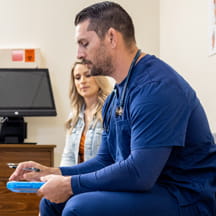What leads to happiness? Is it family, money, health? A meaningful job? The answer to the universal question is the key to eliminating stress, according to Andrew Bernstein, author of “Breaking the Stress Cycle: 7 Steps to Greater Resilience, Happiness and Peace of Mind” and founder of the Resilience Academy.
“We all care about happiness, and it is an important and useful entry point into the conversation around stress and resilience,” Bernstein said during a webinar for Children’s Hospital Association. “This is a way of looking at stress, leadership and team dynamics through a different lens.”
The source of happiness has been discovered, Bernstein says, and it is not what anyone expected.
The Harvard Grant Study, which began in 1938, is the world’s longest-running study into adult development and well-being. In a book summarizing the study’s findings, psychiatrist George Vaillant writes: “There are two pillars of happiness. One is love. The other is finding a way of coping with life that does not push love away.”
The second pillar—a way of coping with life that does not push love away, especially in the face of challenges—is the key to resilience and well-being, Bernstein says. Research has shown that humans suffer from negativity bias, wherein negative experiences hit harder and impress longer than positive experiences. People quickly come down from the highs, while they simmer and steam in the lows. They easily forget a compliment but rarely forget a slight.
“What this means is that to live a happier life, you don’t need more positive, you don’t need more sunshine—you need fewer clouds,” Bernstein says. “You need a better way of handling the negative.”
That is the goal of Bernstein’s seven-step process, called Active Insight, created to uncover and dismantle negative thoughts that lead to stress. He likens the process to the way farmers take manure and, through a deliberate series of steps, turn it into compost. What begins as a toxin transforms into a source of growth. Active Insight transforms stress into insight, accelerating capacity for empathy and peace of mind. The process can be applied to any situation at a children’s hospital, no matter the person’s role or the circumstances, he says. It simply requires a worksheet, a pen and a few minutes.
How it works: Insight on demand
Stress is a psychological process, not a physiological one, Bernstein says. It is caused by a person’s thoughts about negative external forces—deadlines, disasters, or overbearing managers—not from the external forces themselves. “Until there’s a thought, there’s no stress. You don’t get struck by emotions like rain. You have a thought about your job, about your money, about your mother, about your life. Then, stress follows,” he says. “The key to eliminating stress at its source, and not just managing or escaping it, is to create a fundamental shift in the way you think.”
In other words, it requires insight. Typically, insights occur passively over time, without knowing why the light bulb turned on, Bernstein says. In contrast, Active Insight makes the experience of an insight active and repeatable on demand. The practical exercise, performed on a worksheet, is not therapy or motivation or advice, Bernstein emphasizes. It is more like fitness. “In the gym, you intentionally break down your body to provoke change,” he says. “The worksheet is the same thing, but for your mind.”
Performing this exercise over time will develop a skill for reframing every thought that leads to stress. As the skill grows, it can be used on more challenging subjects and will produce more profound insights. When that happens, people will find things that used to bother them no longer do; they’ll find their “clouds” dissolving.
The key to successful teams
This process not only helps individuals become more resilient in their lives and at their job but also helps cultivate highly productive, happy teams. Bernstein points to a Google study that found the primary factor in the highest-performing teams is psychological safety. “How we connect to each other is more important than who is on the team,” he says. “It’s teams that prioritize giving and receiving feedback in a way that feels safe, listen to each other, apologize, are vulnerable and put each other first.”
When team members use the worksheet and normalize working through things together, there is less blame and anger and more honesty and empathy. There’s more accountability. And there’s a culture shift. “If you can get good at this as a skill, it can pay dividends. There are unlimited ways in which having a toolkit that changes how you think in the face of challenges can serve you and your team,” he says. “It’ll change you not because of any magic, but because you’ll have insights that will increase your capacity for honesty, accountability and peace of mind.”
Try the Active Insight exercise.




